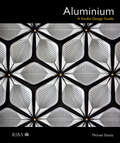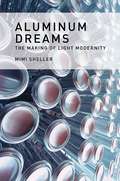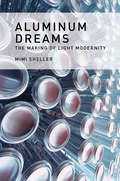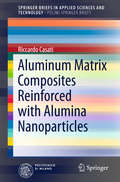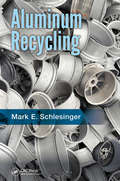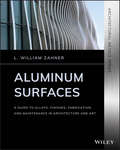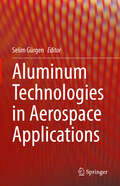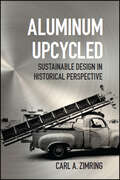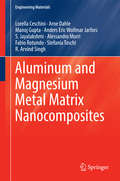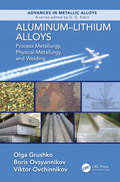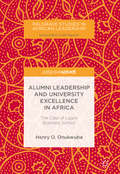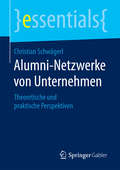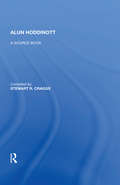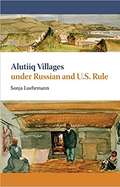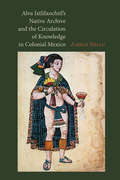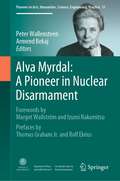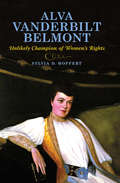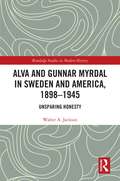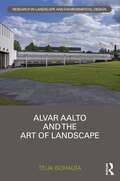- Table View
- List View
Aluminium: A Studio Design Guide
by Michael StaceyAre you making the most of aluminium? Aluminium is one of the most flexible and durable materials to design with. With exceptional strength, durability and affordability, it provides us with more than simply the ability to select products. When understood properly, aluminium becomes something to design with. In a world where over half humankind now lives in cities there is a need to design zero carbon, attractive and durable architecture. This can only be achieved if we are more resourceful, if we achieve more with less by understanding materials well, using finite element analysis and computer aided design. Aluminium can be part of that route to affordable and durable architecture. Recycling aluminium takes only 5% of the energy required to produce primary aluminium and it can be recycled almost infinitely without any loss of properties. Combining an inspirational overview of the use of aluminium in architecture and infrastructure with a technical level of detail, this book shows how useful and versatile aluminium is – and how architects can actually design with it. This book provides access to state of the art research into the best practice in application of aluminium to architecture: from curtain walling and cladding roofing to structural considerations. It demonstrates the material’s design flexibility and how it works well with other materials. Each process will be accompanied by exemplar case studies that demonstrate the potential and application. Woven into the structure of the book are the primary benefits of aluminium: its flexiblilty, its durability, its sustainable properties and its cost-effectiveness. Whether you’re a first year student or a seasoned designer or engineer, this book provides an accessible and deep dive into the uses and benefits of aluminium.
Aluminum Dreams
by Mimi ShellerAluminum shaped the twentieth century. It enabled high-speed travel and gravity-defying flight. It was the material of a streamlined aesthetic that came to represent modernity. And it became an essential ingredient in industrial and domestic products that ranged from airplanes and cars to designer chairs and artificial Christmas trees. It entered modern homes as packaging, foil, pots and pans and even infiltrated our bodies through food, medicine, and cosmetics. In Aluminum Dreams, Mimi Sheller describes how the materiality and meaning of aluminum transformed modern life and continues to shape the world today. Aluminum, Sheller tells us, changed mobility and mobilized modern life. It enabled air power, the space age and moon landings. Yet, as Sheller makes clear, aluminum was important not only in twentieth-century technology, innovation, architecture, and design but also in underpinning global military power, uneven development, and crucial environmental and health concerns. Sheller describes aluminum's shiny utopia but also its dark side. The unintended consequences of aluminum's widespread use include struggles for sovereignty and resource control in Africa, India, and the Caribbean; the unleashing of multinational corporations; and the pollution of the earth through mining and smelting (and the battle to save it). Using a single material as an entry point to understanding a global history of modernization and its implications for the future, Aluminum Dreams forces us to ask: How do we assemble the material culture of modernity and what are its environmental consequences? Aluminum Dreams includes a generous selection of striking images of iconic aluminum designs, many in color, drawn from advertisements by Alcoa, Bohn, Kaiser, and other major corporations, pamphlets, films, and exhibitions.
Aluminum Dreams: The Making of Light Modernity (The\mit Press Ser.)
by Mimi ShellerHow aluminum enabled a high-speed, gravity-defying American modernity even as other parts of the world paid the price in environmental damage and political turmoil.Aluminum shaped the twentieth century. It enabled high-speed travel and gravity-defying flight. It was the material of a streamlined aesthetic that came to represent modernity. And it became an essential ingredient in industrial and domestic products that ranged from airplanes and cars to designer chairs and artificial Christmas trees. It entered modern homes as packaging, foil, pots and pans and even infiltrated our bodies through food, medicine, and cosmetics. In Aluminum Dreams, Mimi Sheller describes how the materiality and meaning of aluminum transformed modern life and continues to shape the world today. Aluminum, Sheller tells us, changed mobility and mobilized modern life. It enabled air power, the space age and moon landings. Yet, as Sheller makes clear, aluminum was important not only in twentieth-century technology, innovation, architecture, and design but also in underpinning global military power, uneven development, and crucial environmental and health concerns. Sheller describes aluminum's shiny utopia but also its dark side. The unintended consequences of aluminum's widespread use include struggles for sovereignty and resource control in Africa, India, and the Caribbean; the unleashing of multinational corporations; and the pollution of the earth through mining and smelting (and the battle to save it). Using a single material as an entry point to understanding a global history of modernization and its implications for the future, Aluminum Dreams forces us to ask: How do we assemble the material culture of modernity and what are its environmental consequences? Aluminum Dreams includes a generous selection of striking images of iconic aluminum designs, many in color, drawn from advertisements by Alcoa, Bohn, Kaiser, and other major corporations, pamphlets, films, and exhibitions.
Aluminum Industry in 1994
by Kenneth CortsAfter reaching all-time highs in excess of $2,500 per ton in 1988 and 1989, aluminum prices fall dramatically in the early 1990s as the former Soviet Union begins exporting far larger quantities of metal. By the beginning of 1994, the price has hit all-time lows (in real terms) and stands at $1,110. The case contains data on world consumption by sector; an accompanying spreadsheet contains detailed cost data for the world's 157 smelters. Together, these allow a thorough supply and demand analysis that illuminates price fluctuations in this industry. A rewritten version of an earlier note.
Aluminum Matrix Composites Reinforced with Alumina Nanoparticles (SpringerBriefs in Applied Sciences and Technology)
by Riccardo CasatiThis book describes the latest efforts to develop aluminumnanocomposites with enhanced damping and mechanical properties and goodworkability. The nanocomposites exhibited high strength, improved dampingbehavior and good ductility, makingthem suitable for use as wires. Since the production of metal matrixnanocomposites by conventional melting processes is considered extremely problematic (because of the poor wettability ofthe nanoparticles), different powder metallurgy routes were investigated,including high-energy ball milling and unconventional compaction methods. Special attention was paidto the structuralcharacterization at the micro- and nanoscale, as uniform nanoparticle dispersion in metal matrixis of prime importance. The aluminum nanocomposites displayed an ultrafine microstructurereinforced with alumina nanoparticles produced in situ or added ex situ. Thephysical, mechanical and functional characteristics of the materials produced were evaluated using different mechanical testsand microstructure investigation techniques. The book presents and discusses the experimental results indetail, and offers suggestions for future research directions.
Aluminum Recycling
by Mark E. SchlesingerWhat makes this book unique is a specific focus on aluminum recovery, rather than just recycling in general. It also offers an integrated discussion of scrap recovery and re-melting operations and includes economic as well as technical elements of recycling. Important topics include a discussion of the scrap aluminum marketplace and how secondary a
Aluminum Smelting in South Africa: Alusaf's Hillside Project
by Kenneth CortsWith prices at all-time lows at the beginning of 1994, South Africa's sole primary aluminum producer--Alusaf--is considering building the world's largest greenfield smelter. Using cost estimates in this case, students can evaluate the relative cost position of this plant in the context of the cost data on other smelters provided in the spreadsheet accompanying "The Aluminum Industry in 1994." By building on the supply and demand analysis supported by that case, students can evaluate the profitability of this massive capital investment.
Aluminum Stress Adaptation in Plants (Signaling and Communication in Plants #24)
by František Baluška Sanjib Kumar PandaThis book is an overview of our current understanding of aluminium toxicity and tolerance in plants. It covers all relevant aspects from molecular and cellular biology, to genetic approaches, root biology and plant physiology. The contribution of arbuscular mycorrhizal fungi to alleviating aluminium toxicity is also discussed. Over 40% of total agricultural land resources are acidic in nature, with aluminium being the major toxicant. Plant roots are particularly susceptible to aluminium stress, but much of the complex mechanism underlying its toxicity and tolerance is unknown and aluminium stress perception in plants remains poorly understood. The diverse facets of aluminium stress adaptation covered in this book are relevant to plant biology students at all levels, as well researchers and it provides a valuable contribution to our understanding of plant adaptation to the changing environment.
Aluminum Surfaces: A Guide to Alloys, Finishes, Fabrication and Maintenance in Architecture and Art (Architectural Metals Series)
by L. William ZahnerA full-color guide for architects and design professionals to the selection and application of aluminum Aluminum Surfaces, second in William Zahner's Architectural Metals Series, provides a comprehensive and authoritative treatment of aluminum applications in architecture and art. It offers architecture and design professionals the information they need to ensure proper maintenance and fabrication techniques through detailed information and full color images. It covers everything from the history of the metal and choosing the right alloy, to detailed information on a variety of surface and chemical finishes and corrosion resistance. The book also features case studies offering architecture and design professionals strategies for designing and executing successful projects using aluminum. Aluminum Surfaces is filled with illustrative case studies that offer strategies for designing and executing successful projects using aluminum. All the books in Zahner’s Architectural Metals Series offer in-depth coverage of today’s most commonly used metals in architecture and art. This important book: Contains a comprehensive guide to the use and maintenance of aluminum surfaces in architecture and art Features full-color images of a variety of aluminum finishes, colors, textures, and forms Includes case studies with performance data that feature strategies on how to design and execute successful projects using aluminum Offers methods to address corrosion, before and after it occurs Discusses the environmental impact of aluminum from the creation process through application Explains the significance of the different alloys and the forms available to the designer Discusses expectations when using aluminum in various exposures For architecture professionals, metal fabricators, developers, architecture students and instructors, designers, and artists working with metals, Aluminum Surfaces offers a logical framework for the selection and application of aluminum in all aspects of architecture.
Aluminum Technologies in Aerospace Applications
by Selim GürgenThis book presents cutting-edge developments and applications of aluminum alloys in the aerospace industry, offering a detailed exploration of the material science and engineering innovations behind aluminum technologies. It examines the properties and advancements of aerospace-grade aluminum alloys while highlighting transformative developments such as aluminum matrix composites, aluminum-based fiber metal laminates, and grain refinement techniques. The book also discusses emerging manufacturing processes, including friction stir welding, and additive friction stir deposition, which open new frontiers for designing and fabricating aerospace components. By bridging material science and practical engineering, this book provides an integrated understanding of how aluminum technologies are shaping the future of aerospace. Aluminum Technologies in Aerospace Applications is a key resource for engineers and researchers looking to stay current on advancements in the field. It highlights the potential of aluminum alloys for innovative aerospace solutions and provides the knowledge and tools needed to address challenges in this fast-evolving industry.
Aluminum Upcycled: Sustainable Design in Historical Perspective (Johns Hopkins Studies in the History of Technology)
by Carl A. ZimringTracing the benefits—and limitations—of repurposing aluminum.Besides being the right thing to do for Mother Earth, recycling can also make money—particularly when it comes to upcycling, a zero waste practice where discarded materials are fashioned into goods of greater economic or cultural value. In Upcycling Aluminum, Carl A. Zimring explores how the metal’s abundance after World War II—coupled with the significant economic and environmental costs of smelting it from bauxite ore—led to the industrial production of valuable durable goods from salvaged aluminum. Beginning in 1886 with the discovery of how to mass produce aluminum, the book examines the essential part the metal played in early aviation and the world wars, as well as the troubling expansion of aluminum as a material of mass disposal. Recognizing that scrap aluminum was as good as virgin material and much more affordable than newly engineered metal, designers in the postwar era used aluminum to manufacture highly prized artifacts. Zimring takes us on a tour of post-1940s design, examining the use of aluminum in cars, trucks, airplanes, furniture, and musical instruments from 1945 to 2015. By viewing upcycling through the lens of one material, Zimring deepens our understanding of the history of recycling in industrial society. He also provides a historical perspective on contemporary sustainable design practices. Along the way, he challenges common assumptions about upcycling’s merits and adds a new dimension to recycling as a form of environmental absolution for the waste-related sins of the modern world. Raising fascinating questions of consumption, environment, and desire, Upcycling Aluminum is for anyone interested in industrial and environmental history, discard studies, engineering, product design, music history, or antiques.
Aluminum and Magnesium Metal Matrix Nanocomposites (Engineering Materials)
by Manoj Gupta S. Jayalakshmi Lorella Ceschini Arne Dahle Anders Eric Wollmar Jarfors Alessandro Morri Fabio Rotundo Stefania Toschi R. Arvind SinghThe book looks into the recent advances in the ex-situ production routes and properties of aluminum and magnesium based metal matrix nanocomposites (MMNCs), produced either by liquid or semi-solid state methods. It comprehensively summarizes work done in the last 10 years including the mechanical properties of different matrix/nanoreinforcement systems. The book also addresses future research direction, steps taken and missing developments to achieve the full industrial exploitation of such composites. The content of the book appeals to researchers and industrial practitioners in the area of materials development for metal matrix nanocomposites and its applications.
Aluminum-Lithium Alloys: Process Metallurgy, Physical Metallurgy, and Welding (Advances in Metallic Alloys)
by Olga Grushko Boris Ovsyannikov Viktor OvchinnokovAluminum–Lithium Alloys: Process Metallurgy, Physical Metallurgy, and Welding provides theoretical foundations of the technological processes for melting, casting, forming, heat treatment, and welding of Al–Li alloys. It contains a critical survey of the research in the field and presents data on commercial Al–Li alloys, their phase composition, microstructure, and heat treatment of the ingots, sheets, forgings, and welds of Al–Li alloys. It details oxidation kinetics, protective alloying, hydrogen in Al–Li alloys, and crack susceptibility. It also discusses grain structure and solidification, as well as structural and mechanical properties. The book is illustrated with examples of Al–Li alloy applications in aircraft structures. Based on the vast experience of the coauthors, the book presents recommendations on solving practical problems involved with melting and casting ingots, welding of Al–Li alloys, and producing massive stampings for welded products. Provides comprehensive coverage of Al–Li alloys, not available in any single source. Presents research that is at the basis of the production technology for of ingots and products made of Al–Li alloys. Combines basic science with applied research, including upscaling and industrial implementation. Covers welding of Al–Li alloys in detail. Discusses gas and alkali-earth impurities in Al–Li alloys. Describes technological recommendations on casting and deformation of Al–Li alloys.
Alumnae Theatre Company: Nonprofessionalizing Theatre in Canada
by Robin C. WhittakerDelving into previously untapped archival resources, Alumnae Theatre Company traces the history and ongoing impact of North America’s longest-running women-led theatre group, Toronto’s Alumnae Theatre Company. The book illuminates the essential yet downplayed relationships between professional and nonprofessionalizing theatre practices, drawing on primary and secondary sources that have contributed to the practice and scholarship of theatre since the early twentieth century. It uses Alumnae as a case study for recognizing female leadership roles that support the development of theatre artists in Canada. The book considers Alumnae’s historical influences on university philanthropy, intellectual modernism, and Toronto’s expanding theatre ecology. It revisits past eras to focus on four dominant perspectives: theatre spaces, festival competition, new play production, and nonprofessionalizing theatre’s relationship to an emerging profession. The book tethers Alumnae’s alterity to contemporary critical notions of the nonprofessionalizing theatre practitioner as counter-culture revolutionary. It urges scholars and practitioners alike to not take for granted the values and possibilities of contemporary nonprofessionalizing theatre practices. Alumnae Theatre Company also serves as a fascinating history of Toronto through the eyes of its oldest active theatre company.
Alumni Leadership and University Excellence in Africa: The Case of Lagos Business School (Palgrave Studies in African Leadership)
by Henry O. OnukwubaFocusing on Lagos Business School (LBS) in Nigeria, this book explores the impact of strong alumni leadership on university excellence in Africa. Strong leadership is crucial to the success of educational institutions and great importance is placed on their effective governance and management. However, many institutions fail to realise the positive impact that a strong alumni body can have on university excellence. Drawing on definitions and theories of leadership, the author seeks to establish the significance of alumni in enhancing a university’s growth and development. Providing comprehensive analysis of LBS, this book is a unique resource for leaders of educational institutions, as well as those studying and teaching in African business schools.
Alumni-Netzwerke von Unternehmen: Theoretische und praktische Perspektiven (essentials)
by Christian SchwägerlChristian Schwägerl beschreibt, wie Alumni-Netzwerke in die Kommunikationsfunktion von Unternehmen integriert sind. Das essentialvermittelt Reflexionswissen über das Spannungsfeld der netzwerkkonstituierenden Peer-to-Peer-Kommunikation und der interessengeleiteten Kommunikation des Unternehmens mit den ehemaligen Mitarbeiterinnen und Mitarbeitern. Darüber hinaus stellt der Autor die Wertbeiträge dar, die Unternehmen auf ihrem Absatz-, Ressourcen- und Meinungsmarkt mithilfe von Alumni-Netzwerken erzielen können.
Alun Hoddinott: A Source Book (Bio-bibliographies In Music Ser. #No. 44)
by R. Craggs StewartAlun Hoddinott is the most important living Welsh composer and one of the most distinguished and prolific composers of his generation internationally. His works have been performed in major centres as far afield as Tokyo and Berlin, Melbourne and Leipzig, New York and Venice as well as the major festivals in Wales and England. He is one of the very few composers to have been commissioned to compose a concerto for Mstislav Rostropovitch.Born in Bargoed, Glamorganshire, in August 1929, Alun Hoddinott started to play the violin and compose at an early age. Some of his works were performed and broadcast whilst he was a student at University College, Cardiff and he later studied with the Australian composer and pianist Arthur Benjamin. His first major success was his Clarinet Concerto No.1, given by Gervaise de Peyer and the Halle Orchestra under John Barbirolli at the 1954 Cheltenham Music Festival.This Source Book lists all Hoddinott's compositions from 1946 to 2005, almost 60 years of phenomenal output, and shows he has achieved a mastery of composition which embraces almost every musical medium. With information given on first performances, manuscript locations and recordings, in addition to details of composition dates, authors/librettists, durations, commissions and dedications amongst much else, this book is a key reference for all those interested in Alun Hoddinott and his music.
Alusaf Hillside Project
by John R. Wells Kenneth CortsThe aluminum industry has suffered from long periods of depressed prices and profits interspersed with relatively short-lived price and profit peaks. The case investigates why, this has occured, focusing on the decision Alusaf must make on whether to invest in a major new facility in the face of depressed aluminum prices. Courseware provides cost data on all the facilities in the industry to develop a supply curve. It also provides a supply and demand model that allows students to investigate: the drivers of average industry profitability and relative profitability of individual players in it; the impact of changes in demand over the economic cycle on the price of metal; the impact of different elasticities of demand on price and profitability; the impact of oligopolistic pricing on industry profitability; the impact of adding capacity on industry profitability; and the ability of a firm to preempt the aluminum market. A rewritten version of an earlier case.
Alutiiq Villages Under Russian and U. S. Rule
by Sonja Luehrmann S. LuehrmannSonja Luehrmann’s volume examines Alutiiq history within the larger context of Russian and American expansionism. The author uses source material in both English and Russian in order to create a work focused on the intersection of the two colonial perspectives—throwing light on our understanding of the differences in the way each society incorporated the Alutiiq community, both as a labor force and a social entity. In a series of map essays, Luehrmann examines the changing patterns of settlement and demography among the Alutiiq as the population responded to the conditions they encountered: economic exploitation, new cultural influences, intermarriage, disease, and the eruption of Novarupta. The addition of Russian source material fills an important blank in this unique history and makes Alutiiq Villages Under Russian and U.S. Rule a major resource for anyone working on Alutiiq history or the region’s history in the Russian colonial period.
Alva Ixtlilxochitl's Native Archive and the Circulation of Knowledge in Colonial Mexico
by Amber BrianModern Language Association's Katherine Singer Kovacs Prize, Honorable Mention, 2016 Born between 1568 and 1580, Alva Ixtlilxochitl was a direct descendant of Ixtlilxochitl I and Ixtlilxochitl II, who had been rulers of Texcoco, one of the major city-states in pre-Conquest Mesoamerica. After a distinguished education and introduction into the life of the empire of New Spain in Mexico, Ixtlilxochitl was employed by the viceroy to write histories of the indigenous peoples in Mexico. Engaging with this history and delving deep into the resultant archives of this life's work, Amber Brian addresses the question of how knowledge and history came to be crafted in this era. Brian takes the reader through not only the history of the archives itself, but explores how its inheritors played as crucial a role in shaping this indigenous history as the author. The archive helped inspire an emerging nationalism at a crucial juncture in Latin American history, as Creoles and indigenous peoples appropriated the history to give rise to a belief in Mexican exceptionalism. This belief, ultimately, shaped the modern state and impacted the course of history in the Americas. Without the work of Ixtlilxochitl, that history would look very different today.
Alva Ixtlilxochitl’s Native Archive and the Circulation of Knowledge in Colonial Mexico
by Amber BrianBorn between 1568 and 1580, Alva Ixtlilxochitl was a direct descendant of Ixtlilxochitl I and Ixtlilxochitl II, who had been rulers of Texcoco, one of the major city-states in pre-Conquest Mesoamerica. After a distinguished education and introduction into the life of the empire of New Spain in Mexico, Ixtlilxochitl was employed by the viceroy to write histories of the indigenous peoples in Mexico. Engaging with this history and delving deep into the resultant archives of this life's work, Amber Brian addresses the question of how knowledge and history came to be crafted in this era.Brian takes the reader through not only the history of the archives itself, but explores how its inheritors played as crucial a role in shaping this indigenous history as the author. The archive helped inspire an emerging nationalism at a crucial juncture in Latin American history, as Creoles and indigenous peoples appropriated the history to give rise to a belief in Mexican exceptionalism. This belief, ultimately, shaped the modern state and impacted the course of history in the Americas. Without the work of Ixtlilxochitl, that history would look very different today.
Alva Myrdal: A Pioneer in Nuclear Disarmament (Pioneers in Arts, Humanities, Science, Engineering, Practice #31)
by Peter Wallensteen Armend BekajThis book is about the importance of nuclear disarmament and the work pursued by Alva Myrdal, a pioneering social activist, diplomat, cabinet minister, and disarmament negotiator. She was awarded the Nobel Peace Prize in 1982 together with Alfonso García Robles "for their work for disarmament and nuclear and weapon-free zones". Prominent academics, politicians and practitioners have contributed reflections on Myrdal’s achievements and their impact on the world today. Furthermore, a sample of Myrdal’s own writings on nuclear disarmament are included, as well as significant speeches and a bibliography of her publications on nuclear matters. Alva Myrdal was born in Uppsala, Sweden, in 1902, graduated from college in Stockholm in 1924, and continued higher education at Uppsala University in the 1930s. She was a prolific author and reformer, specializing in social affairs, women’s roles and nuclear disarmament. She was Sweden’s Ambassador to India in the 1950s, for Nuclear Disarmament in the 1960s and 1970s, and a member of the Cabinet 1967-1973. Her most well-known works are "The Game of Disarmament" (1976), "Nation and Family" (1941), and "Women's Two Roles" (1956, with Viola Klein). Her book "The Game of Disarmament" (1976) is a key work in disarmament. The Alva Myrdal Centre for Nuclear Disarmament was set up at Uppsala University in 2021 to contribute new ideas and concrete measures towards the elimination of nuclear weapons. Both editors are associated with the Centre, Professor Peter Wallensteen as a member of the board and leader of one of its working groups, and Dr. Armend Bekaj as a researcher. - This book is relevant for students of international relations and policy-makers on issues of peace and conflict. - It provides background documentation on the difficulties in achieving disarmament. - It illustrates the significant role women can play to infuse new ideas into a men’s world. - It displays the importance of persistence, rationality, ingenuity and knowledge in furthering nuclear disarmament. - It shows that Alva Myrdal’s efforts can be an inspiration for new generations.
Alva Vanderbilt Belmont: Unlikely Champion of Women's Rights
by Sylvia D. HoffertA fascinating biography of the New York socialite who played a surprising role in the fight for suffrage. Born in the middle of the nineteenth century, Alva Vanderbilt Belmont was known to be domineering, temperamental, and opinionated. She married two millionaires, and pressured her daughter to wed an aristocrat. This resolve to get her own way regardless of the consequences stood her in good stead when she joined the American woman suffrage movement in 1909. Thereafter, she used her wealth, her administrative expertise, and her social celebrity to help convince Congress to pass the 19th Amendment and then to persuade the exhausted leaders of the National Woman&’s Party to initiate a worldwide equal rights campaign. In this book, Sylvia D. Hoffert argues that Belmont was a feminist visionary and that her financial support was crucial to the success of the suffrage and equal rights movements. She also shows how Belmont&’s activism, and the money she used to support it, enriches our understanding of the personal dynamics of the American woman&’s rights movement. Drawing upon and analyzing Belmont&’s own memoirs, she illustrates how this determined woman went about the complex and collaborative process of creating her public self. &“Engaging . . . Highly recommended.&” —Choice
Alva and Gunnar Myrdal in Sweden and America, 1898–1945: Unsparing Honesty (Routledge Studies in Modern History)
by Walter A. JacksonAlva and Gunnar Myrdal are the only couple ever awarded Nobel prizes as individuals: Gunnar won the prize in Economics in 1974, and Alva won the Peace Prize in 1982. This dual biography examines their work as architects of the modern welfare state and probes the connections between the public and private dimensions of their lives. Drawing on their extensive personal correspondence and diaries between their electrifying first meeting in 1919 and their protracted marital crisis in the early 1940s, this book presents the psychologist and the economist as they sought to combine love and work in an equal partnership. Alva and Gunnar simultaneously experimented with a new kind of intimate relationship and designed the social supports necessary for women both to bear and raise children and to contribute their talents and energies to society. Like all genuine revolutionaries, they struggled to free themselves from the burdens of their upbringings; to evaluate their own actions with what they called "unsparing honesty," and to test their policy recommendations in practice, measuring everything against the values they shared.
Alvar Aalto and The Art of Landscape (Routledge Research in Landscape and Environmental Design)
by Teija IsohautaAlvar Aalto and The Art of Landscape captures the essence of the Finnish architect’s landscape concept, emphasising culture and tradition, which characterised his approach to and understanding of architecture as part of the wider environment. From the forests of his youth to sights from his travels, Alvar Aalto (1898–1976) was influenced by outdoor landscapes. Throughout his career, he felt the need to shape the terrain and this became a signature of his architecture. Divided into five chapters, this book traces Aalto’s relationship with landscape, starting with an analysis of his definitions and descriptions of landscape language, which ranged from natural references and biological terms, to synonyms and comparisons. It includes beautifully illustrated case study projects from the 1950s and 1960s, discussing Aalto’s transformation of different landscapes through topography, terracing and tiers, ruins and natural elements, horizon outlines, landmarks, and the repetition of form. Featuring archival sketches, garden drawings, and plans, the book also contains Aalto’s text ‘Architecture in the Landscape of Central Finland’ from 1925 in the appendix. This book provides fascinating, untold insights into Aalto’s relationship with landscape and how this developed during his lifetime, for scholars, researchers, and students interested in architecture and landscape history, landscape art, and cultural studies.
